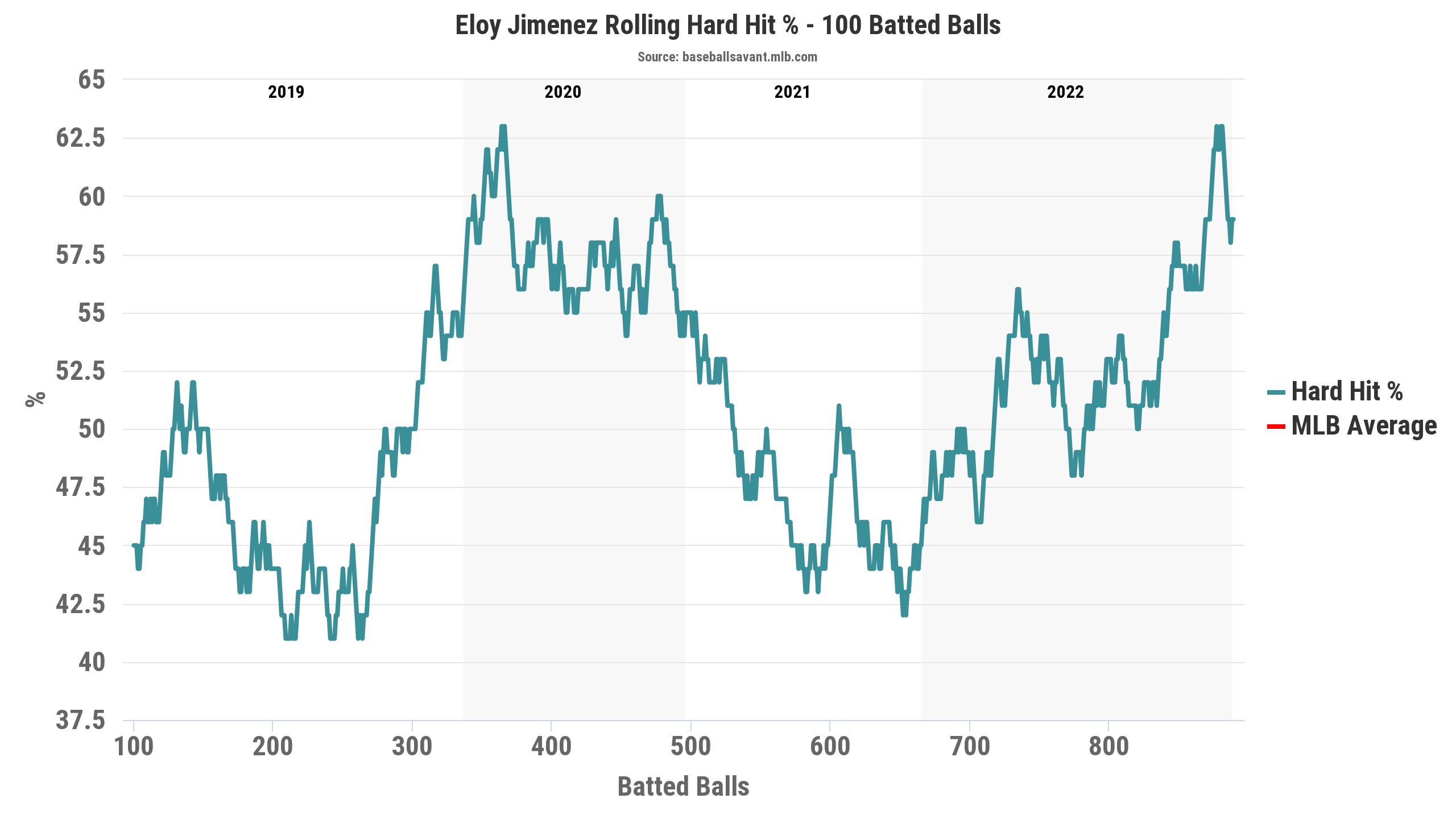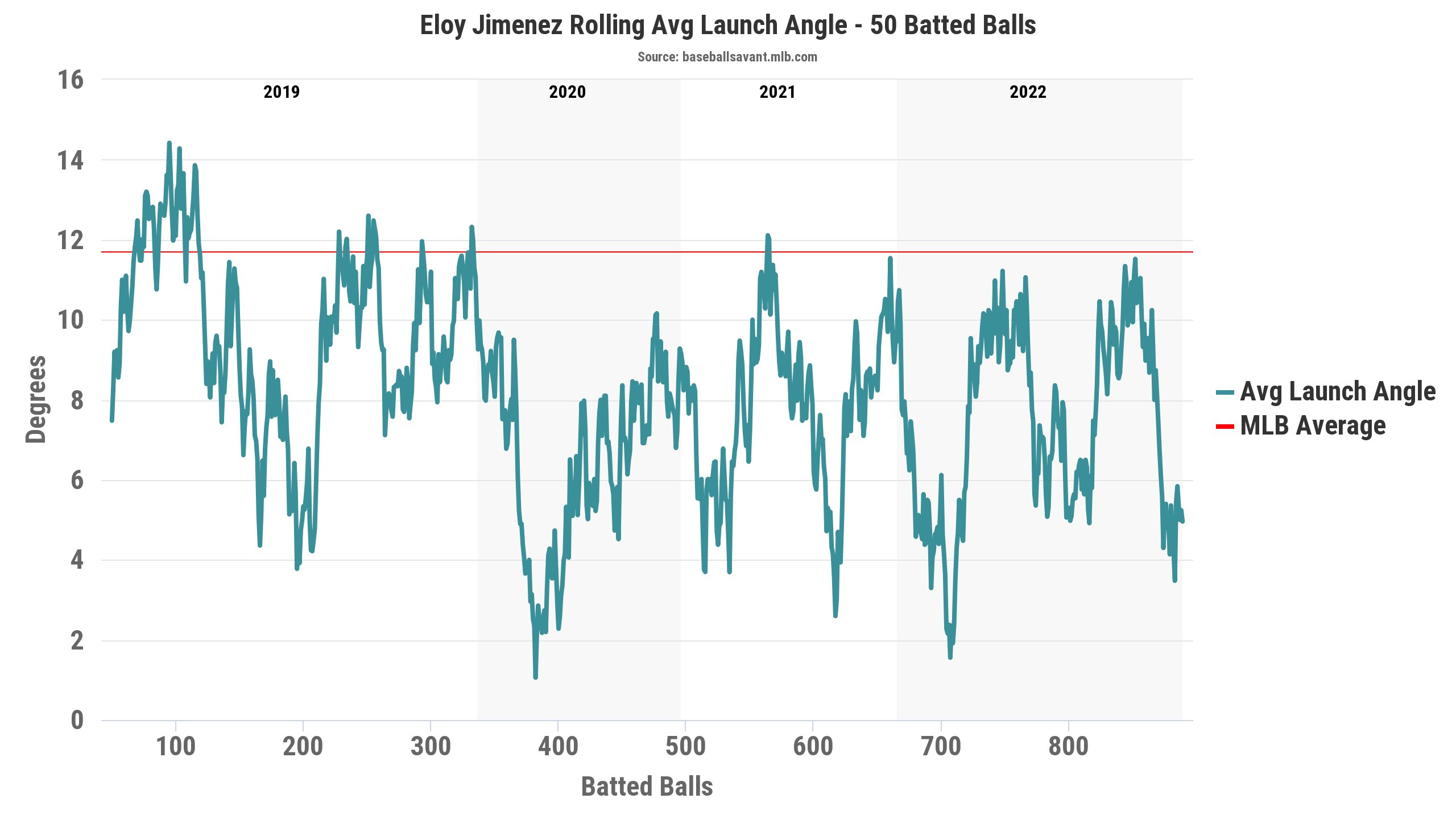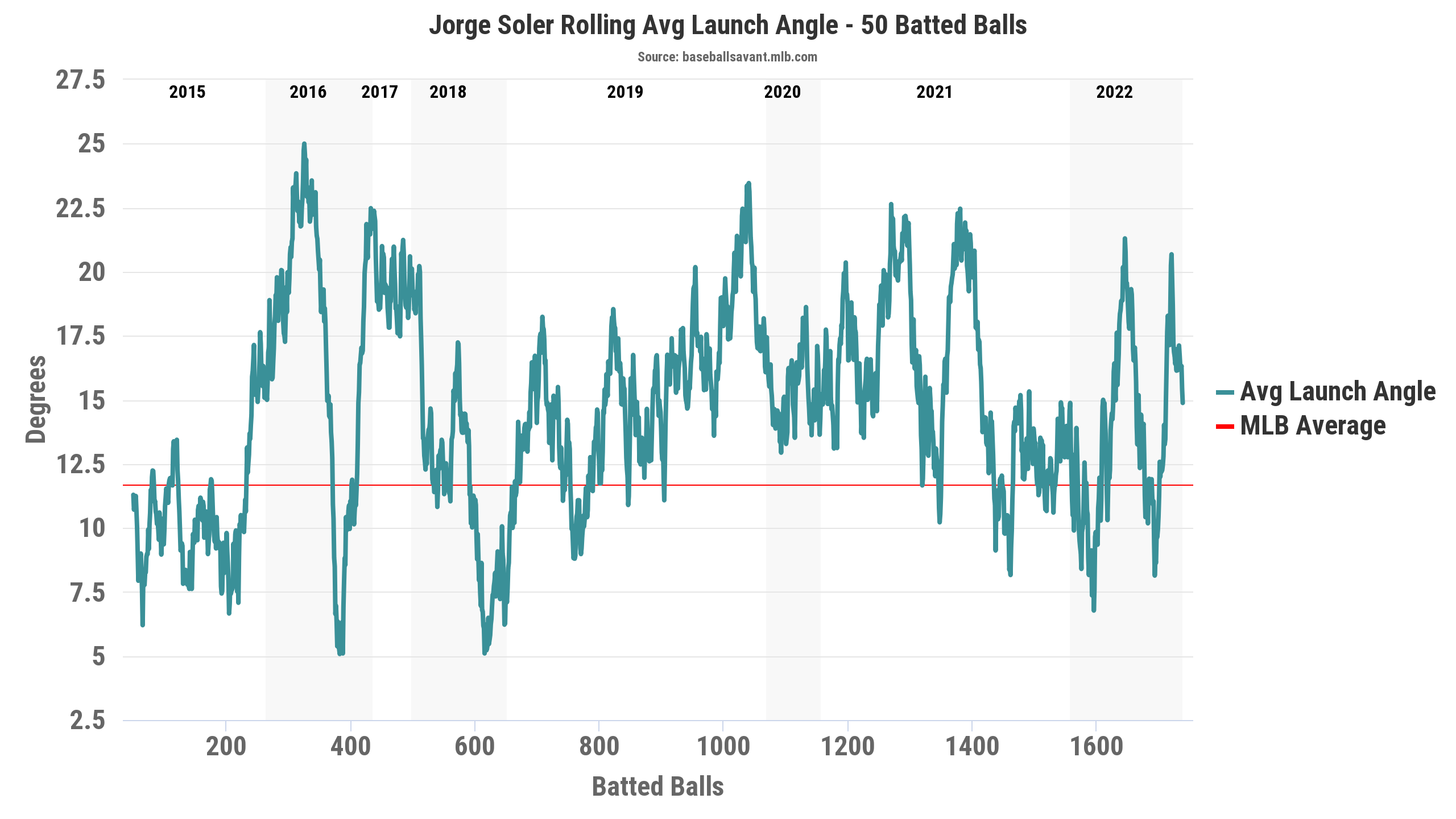There is no question that White Sox fans and fantasy baseball players alike have been patiently waiting on Eloy Jiménez to become a franchise star over the past couple of years.
After all, Jiménez was named the top prospect in the White Sox system by Baseball America in 2018 and 2019, as well as the best prospect in the Cubs system in 2017 (prior to his trade to the South Side).
In his first two seasons, he seemed on the cusp of catapulting into stardom.
During his rookie year in 2019, Jiménez hit .267 and added 31 home runs and 79 RBI in 122 games and 504 plate appearances. While he finished fourth in the AL Rookie of the Year voting, it was still a successful campaign that generated a lot of hope with White Sox fans and fantasy baseball managers.
4th in the voting, but Rookie of the Year to us. Who is excited for more Eloy Jiménez in 2020?! pic.twitter.com/AWGfDXwGlL
— Chicago White Sox (@whitesox) November 12, 2019
In the COVID-shortened season of 2020, he followed that solid rookie year with an even more impressive sophomore season. Over 226 plate appearances, he improved his batting average to .296, and he also hit 14 home runs and collected 41 RBI as well.
Going into 2021, the consensus in the fantasy baseball community seemed to be that Jiménez was a bonafide first-round talent who could carry fantasy teams in most standard category leagues.
However, injuries have held him back and dimmed his once brightly shining star over the past two seasons.
An injury in Spring Training limited Jiménez to only 55 games in 2021. In 2022, he only played 84 games due to a hamstring issue suffered at the beginning of the season.
Granted, after a subpar 2021 for his standards (.249 average; 100 wRC+), Jiménez did have a bounceback season of sorts in 2022. He hit .295 with 16 home runs and 54 RBI while producing a wRC+ of 144, a career-high. That being said, the expectations seem tempered for 2023 in the fantasy community, especially with his injury history and age (he is 26 years old).
According to Fantasy Pros consensus ADP rankings, Jiménez is coming in around 76th overall, putting him around other hitters like Starling Marte (73rd), Bryce Harper (74th), Salvador Perez (78th), and Xander Bogaerts (80th). While that isn’t necessarily bad company for Jiménez to be around, considering his recent injury history, the ADP still feels low for a player with his power and production profile.
Nonetheless, it isn’t out of the question to think that Jiménez could not just break out in 2023 if he can stay healthy, but perhaps be better than ever before.
And new manager Pedro Grifol and his coaching staff could be the reason why Jiménez is fully able to unleash his potential at the plate, starting this season.
Small Sample; Big Production in 2022
In 2021, Jiménez missed 117 days due to recovery from surgery to repair a torn pectoral tendon (which he suffered on a defensive play in Spring Training). The White Sox quickly got him back on the field, but it was obvious that he wasn’t the same hitter post-surgery.
Over 231 plate appearances, his batting average plummeted to .249, and his wOBA went from .364 in 2020 to .317 in 2021. In addition, his batted ball data showcased that Jiménez wasn’t fully himself at the plate in his return from surgery. His average exit velocity on batted balls was only 90.5 MPH and his hard-hit rate was only 44.6 percent. Those were 1.9 MPH and 11.1 percent declines from his marks in 2020.
Even though hamstring issues sidelined him for 74 days in 2022, Jiménez was able to recapture the power stroke that made him one of the American League’s most intriguing hitters back in 2019 and 2020.
His batting average and wOBA bounced back to .295 and .370, respectively. Furthermore, his average exit velocity spiked up by 2.3 percent, and his hard-hit rate not only improved to 54.9 percent but progressed nicely throughout the year after a down year in 2021.
Here’s a look at his rolling hard-hit rate chart, via Baseball Savant. It is easy to notice his 2022 trend in hard-hit rate appears similar to what he produced in 2020 and 2019.

Courtesy of Baseball Savant
Jiménez did get off to a slow start in 2022 when it came to hitting the ball hard, based on the chart above. Not surprisingly, that also correlated with a slow start overall for him at the plate as well (which wasn’t helped by the hamstring issues).
That said, once Jiménez got fully healthy, he became one of the White Sox’s most productive hitters. That was especially true in the second half of 2022, which can be seen in the table of advanced data below:
Even though Jiménez only accumulated 327 plate appearances overall in 2022, he did have 226 in the second half of the year, a sign that he was healthier after the break. After the All-Star Break, he also managed to be one of the most productive hitters in baseball, especially on a wRC+ end.
Here’s a look at the top hitters in the second half of last year, ranked by wRC+:
Jiménez ranked 5th overall in the second half on a wRC+ end with his 169 mark. Additionally, he also performed better on that end than bigger names such as Freeman, Ohtani, Machado, and Arenado, who all rank within the Top 40 on an ADP end so far during this draft season.
Even though it wasn’t a huge sample, Jiménez proved that he was back to his 2019 and 2020 self as a hitter in the last couple of months of the 2022 season.
Is Launch Angle a Problem?
On a batted ball and even barrel rate end, there is a lot to be optimistic about with Jiménez for the upcoming 2023 season. However, one aspect of Jiménez’s profile that is a bit concerning is his low launch angle and high groundball rate for a power hitter.
Unfortunately, this is not something new for Jiménez, as he has demonstrated questionable skills in these two areas since his rookie year.
According to Baseball Savant, Jiménez has a career launch angle of 8.0 degrees, which includes a 7.4-degree mark a season ago. Furthermore, he has consistently been below average in terms of his launch angle compared to the rest of the league, which can be seen in the rolling average launch angle chart below:

Courtesy of Baseball Savant
Now, if one compares the launch angle chart to his hard-hit rate chart, it definitely shows how Jiménez is on different ends of the spectrum in those categories. When it comes to hitting the ball hard, he has consistently been well-above league average (there’s a reason why the red line is not visible on the hard-hit rate chart; he has been THAT FAR ABOVE league average).
In terms of lifting the ball though? He has been below average, especially over the past three seasons.
Great exit velocity with a low launch angle is only going to produce results like this at-bat back in September in Minnesota against Twins pitcher Bailey Ober:
https://gfycat.com/wellmademilkygoitered
Jiménez produces an exit velocity of 110.3 MPH on Ober’s slider. In fact, it was the 11th-hardest ball he hit last year, according to Savant. However, because it only had a launch angle of one, it produced an easy double play for the Twins infield.
Now, let’s take a look at a Robbie Ray pitch back in April also located low in the strike zone. This time, Jiménez is able to generate a better launch under the ball (even in the pouring rain):
https://gfycat.com/eminentoffensiveamphiuma
Jiménez not only produces an exit velocity of 111.4 MPH but a launch angle of 26 degrees. Not surprisingly, the result is a titanic home run.
The more often he produces those kinds of exit velocity and launch angle combos in his at-bats, the more successful and consistent he will be at the plate in 2023 and beyond.
When diving deeper into his launch angle metrics, it’s interesting to see how it correlates with his general batted ball data over his career, especially when it comes to his groundball and pull rates, which can be viewed in the table below:
In the two seasons when he produced his lowest launch angles (2020 and 2022), he also sported career highs in groundball rate (51.9 and 50.4 percent, respectively) and career lows in pull percentage (36.1 and 37.5 percent). Even though Jiménez does not hit a tremendous number of fly balls, he has made them count, as evidenced by his plus-20 HR/FB rates over his career.
If Jiménez can adjust to pull and launch the ball more, not only would his flyball rates increase, but his home run numbers (and consequently other metrics like runs, RBI, etc.) will also spike up in a positive fashion as well.
This situation begs people to ask this question:
How can the White Sox make that happen, especially after Jiménez has produced four years of similar data with his launch angle?
Can Pedro Grifol and Mike Tosar Help?
It’s not surprising that one of the first calls that new White Sox manager Grifol made was to Jiménez, which was profiled by this promotional clip on Twitter, shortly after Grifol’s introductory press conference back on November 3rd.
📞 Pedro Grifol calling… pic.twitter.com/dCsU5ldzgR
— Chicago White Sox (@whitesox) November 3, 2022
For many White Sox fans, the decision to replace Tony La Russa was an odd choice. Not only did Grifol have no MLB managerial experience, but he was previously a bench coach with the Kansas City Royals, who have not had a winning season since 2015.
That said, Grifol’s success in connecting with young Latin American hitters, and working with assistant coach Mike Tosar to help them improve at the plate is a big reason why people should be optimistic about not only Grifol’s potential as manager on the South Side but Jiménez’s outlook at the plate in 2023.
Salvador Perez and Jorge Soler are two examples of hitters who thrived after working with Grifol and Tosar in Kansas City.
Back in 2017, Soler was coming off a disappointing campaign with the Royals after being traded over to Kansas City from the Cubs in exchange for closer Wade Davis in the previous offseason. Soler only hit .144 with a .503 OPS in 110 at-bats, and many wondered if he would even stick in Kansas City in 2018, let alone provide any value in what was a controversial trade at the time among Royals fans.
Prior to the 2018 season, Grifol and Tosar took Soler under their wings, and not only provided valuable mentorship but a deep analysis of his swing and approach. Here’s a valuable tidbit from The Athletic’s Alec Lewis, who wrote a piece on what led to Soler’s 48-home-run season in 2019, which set the Royals’ single-season record at the time.
From a swing perspective, Tosar thought Soler had terrific mechanics, but Grifol had said the Royals wanted to see Soler in more of a launch position. The goal?
“Putting Jorge in a more ‘bad-intentions’ position,” Grifol said.
How do you do that as a hitter? You adjust your eyes.
Soler’s swing plane worked well, but he was often lunging for the baseball earlier than necessary. If he could keep his eyes “behind the baseball” as the ball entered the zone, he could maintain balance.
Tosar tossed pitch after pitch. Eventually, Soler began to “launch” the baseball. He went to spring training in 2018 looking like the player Epstein thought he could be, and a month into the ’18 season, Soler was batting .296/.433/.465.
“‘You have to turn yourself into a lion’: The story behind Jorge Soler’s breakout season” by Alec Lewis; The Athletic; August 15th, 2019
As mentioned in the piece, Grifol and Tosar helped him attack the ball more in his at-bats and improve his launch angle. Based on Soler’s rolling launch angle chart, it seems like that work did produce worthwhile results in this area, especially from 2019 to 2021.

Courtesy of Baseball Savant
More importantly, Soler’s work with Grifol and Tosar did not just produce a better average launch angle on batted balls over a three-year period, but it also led to more home runs over that period of time as well.
Jorge Soler just hit his 34th HR of 2019 (in his 120th game).
From 2015-18, he hit a total of 33 homers in 283 games! pic.twitter.com/aEh1TyscEx
— MLB Stats (@MLBStats) August 11, 2019
Not long after Soler’s breakout, Perez also increased his offseason work with Tosar prior to the 2020 season. Perez long had a relationship with Grifol, who worked primarily with catchers in the Royals system before becoming bench coach in 2020. However, it wasn’t until after Soler’s success in 2019 (Perez missed all of 2019 due to Tommy John) that Perez and Tosar became a regular working pair in the offseason.
Mike Tosar, specifically, is a major reason as to why Salvador Perez has done what he's done at the plate the last couple of years. He was huge in Jorge Soler's progression. And that of MJ Melendez. Has been around some of the very best. https://t.co/rrEBHzsW30
— Alec Lewis (@alec_lewis) May 16, 2022
The results from his work with Tosar and Grifol were almost immediate for Perez.
He hit 11 home runs in 37 games and also posted an OPS of .986 to boot during the COVID-shortened 2020 season. In 2021, Perez not only tied Soler’s 48-home run mark, but he also collected 121 RBI and posted a .860 OPS, which helped him earn a Silver Slugger award that season.
Slugging his way into history.
Congrats to Salvy on his franchise-record fourth Silver Slugger Award! pic.twitter.com/UosTD44VIb
— Kansas City Royals (@Royals) November 11, 2021
It would not be surprising to see Grifol and Tosar have a similar impact on Jiménez as they did on Soler and Perez.
In fact, it could be even greater, especially considering Jiménez is a bit younger than Soler and Perez were when they began work with Tosar specifically.
Outlook on Jiménez for 2023
When it comes to comparing Jiménez’s Statcast batted ball metrics to Perez and Soler since 2019, it’s pretty remarkable how closely the White Sox outfielder aligns to the Royals catcher and now Marlins outfielder, as seen in the table below:
The main difference in the 2019 to 2022 data sample between Jiménez and Perez and Soler is the launch angle. Jiménez’s launch angle is 7.3 degrees lower than Soler’s, and 8.4 degrees lower than Perez’s.
It makes one wonder what Jiménez can do if Tosar and Grifol can help him make that adjustment to produce better average launch under batted balls in 2023.
If those kinds of adjustments can be made by Jiménez, much like Soler in 2019 and Perez in 2020 and 2021, then it isn’t out of the question to think Jiménez can not only match that 31-home run total of 2019 again but perhaps reach the 40+ homer mark by the end of the season.
And if he’s hitting 40+ home runs? It is likely that he will be collecting triple digits in RBI and maybe posting a high batting average in the .280-.300 range as well.
Those are numbers that will make Jiménez a steal for a pick in his ADP range in many draft formats. Furthermore, that kind of performance could also help the White Sox return to the postseason as well as result in him being an All-Star and possibly the AL MVP in 2023.
He has to stay healthy, of course, which has been a challenge over the past two years for Jiménez (and honestly many White Sox players in general).
But if he does stay on the field and in the lineup, it wouldn’t be surprising to see Jiménez become the next (and perhaps most) successful Grifol and Tosar “story” in 2023.
Photo by Frank Jansky/Icon Sportswire | Adapted by Doug Carlin (@Bdougals on Twitter)

